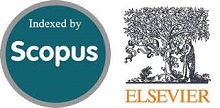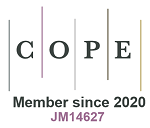2D-QSPR Study of Olfactive Thresholds for Pyrazine Derivatives Using DFT and Statistical Methods
Downloads
In this study, we have established two-dimensional quantitative structure propriety relationships (2D-QSPR) model, for a group of 78 molecules based on pyrazine, these molecules were subjected to a 2D-QSPR analyze for their odors thresholds propriety using stepwise Multiple Linear Regression (MLR). The 35 parameters are calculated for the 78 studied compounds using the Gaussian 09W, ChemOffice and ChemSketch softwares. Quantum chemical calculations are used to calculate electronic and quantum chemical descriptors, using the density functional theory (B3LYP/6-31G (d) DFT) methods.
The model was used to predict the odors thresholds propriety of the test and training set compounds, and the statistical results exhibited high internal and external consistency as demonstrated by the validation methods.Downloads
Yagnam, Swetha, Adinarayana Murthy Akondi, Rajiv Trivedi, Balaji Rathod, Reddy Shetty Prakasham, and B. Sridhar. "Spirooxindole-Fused Pyrazolo Pyridine Derivatives: NiO–SiO2 Catalyzed One-Pot Synthesis and Antimicrobial Activities.” Synthetic Communications 48, no. 3 (January 8, 2018): 255–266. doi:10.1080/00397911.2017.1393687.
Adams, An, Viviana Polizzi, Martinus van Boekel, and Norbert De Kimpe. "Formation of Pyrazines and a Novel Pyrrole in Maillard Model Systems of 1,3-Dihydroxyacetone and 2-Oxopropanal.” Journal of Agricultural and Food Chemistry 56, no. 6 (March 2008): 2147–2153. doi:10.1021/jf0726785.
Miyazawa Y, Ohkubo Y, Haraguchi K, Takahashi M, Yoshida S. Flavor Modulator Having Pyridine Derivative or Salt Thereof As Active Ingredient. US Patent App. 15/712,381; 2018.
Shimazaki, Kazuko, Takashi Inoue, Hiroki Shikata, and Kazuhisa Sakakibara. "Evaluation of the Odor Activity of Pyrazine Derivatives Using Structural and Electronic Parameters Derived from Conformational Study by Molecular Mechanics (MM3) and Ab Initio Calculations.” Journal of Molecular Structure 749, no. 1–3 (July 2005): 169–176. doi:10.1016/j.molstruc.2005.03.044.
Deng, Baichuan, Hongrong Long, Tianyue Tang, Xiaojun Ni, Jialuo Chen, Guangming Yang, Fan Zhang, et al. "Quantitative Structure-Activity Relationship Study of Antioxidant Tripeptides Based on Model Population Analysis.” International Journal of Molecular Sciences 20, no. 4 (February 25, 2019): 995. doi:10.3390/ijms20040995.
Chtita, Samir, Mounir Ghamali, Majdouline Larif, Rachid Hmamouchi, Mohammed Bouachrine, and Tahar Lakhlifi. "Quantitative Structure–Activity Relationship Studies of Anticancer Activity for Isatin (1H-Indole-2,3-Dione) Derivatives Based on Density Functional Theory.” International Journal of Quantitative Structure-Property Relationships 2, no. 2 (July 2017): 90–115. doi:10.4018/ijqspr.2017070108.
Baviskar, Bhushan A, Sharada L Deore, and Sagar Alone. "2D QSAR Study on Saponins of Pulsatilla Koreana as an Anticancer Agent.” Pharmacognosy Communications 9, no. 1 (January 15, 2019): 02–06. doi:10.5530/pc.2019.1.2.
Wang, Tao, Xin-song Yuan, Mian-Bin Wu, Jian-Ping Lin, and Li-Rong Yang. "The Advancement of Multidimensional QSAR for Novel Drug Discovery - Where Are We Headed?” Expert Opinion on Drug Discovery (June 8, 2017): 1–16. doi:10.1080/17460441.2017.1336157.
De Souza, Anacleto S., Leonardo G. Ferreira, and Adriano D. Andricopulo. "2D and 3D QSAR Studies on a Series of Antichagasic Fenarimol Derivatives.” International Journal of Quantitative Structure-Property Relationships 2, no. 1 (January 2017): 44–63. doi:10.4018/ijqspr.2017010104.
Mihara, Satoru, Hideki Masuda, Hideki Tateba, and Tohru Tuda. "Olfactive Properties of 3-Substituted 5-Alkyl-2-Methylpyrazines.” Journal of Agricultural and Food Chemistry 39, no. 7 (July 1991): 1262–1264. doi:10.1021/jf00007a013.
Buchbauer, Gerhard, Christian Th. Klein, Bettina Wailzer, and Peter Wolschann. "Threshold-Based Structure−Activity Relationships of Pyrazines with Bell-Pepper Flavor.” Journal of Agricultural and Food Chemistry 48, no. 9 (September 2000): 4273–4278. doi:10.1021/jf000192h.
Wagner, R., M. Czerny, J. Bielohradsky, and W. Grosch. "Structure-Odour-Activity Relationships of Alkylpyrazines.” Zeitschrift Für Lebensmitteluntersuchung Und -Forschung A 208, no. 5–6 (May 3, 1999): 308–316. doi:10.1007/s002170050422.
Grosch, Werner, Michael Czerny, Robert Wagner, and Florian Mayer. "STUDIES ON THE AROMA OF ROASTED COFFEE.” Flavour Science (1996): 200–205. doi:10.1533/9781845698232.4.200.
Cerny, Cristoph, and Werner Grosch. "Precursors of Ethyldimethylpyrazine Isomers and 2,3-Diethyl-5-Methylpyrazine Formed in Roasted Beef.” Zeitschrift Für Lebensmittel-Untersuchung Und -Forschung 198, no. 3 (March 1994): 210–214. doi:10.1007/bf01192597.
Czerny, Michael, Robert Wagner, and Werner Grosch. "Detection of Odor-Active Ethenylalkylpyrazines in Roasted Coffee.” Journal of Agricultural and Food Chemistry 44, no. 10 (January 1996): 3268–3272. doi:10.1021/jf9600824.
Zakarya, Driss, Lahbib Farhaoui, Mohammed Hamidi, and Mohammed Bouachrine. "Structure–olfactive Threshold Relationships for Pyrazine Derivatives.” Journal of Molecular Modeling 12, no. 6 (May 5, 2006): 985–989. doi:10.1007/s00894-006-0115-1.
Rojas, Cristian, Pablo R. Duchowicz, Piercosimo Tripaldi, and Reinaldo Pis Diez. "Quantitative Structure–property Relationship Analysis for the Retention Index of Fragrance-Like Compounds on a Polar Stationary Phase.” Journal of Chromatography A 1422 (November 2015): 277–288. doi:10.1016/j.chroma.2015.10.028.
Svetnik, Vladimir, Andy Liaw, Christopher Tong, J. Christopher Culberson, Robert P. Sheridan, and Bradley P. Feuston. "Random Forest: A Classification and Regression Tool for Compound Classification and QSAR Modeling.” Journal of Chemical Information and Computer Sciences 43, no. 6 (November 2003): 1947–1958. doi:10.1021/ci034160g.
Rodgers, Sarah L., Andrew M. Davis, Nick P. Tomkinson, and Han van de Waterbeemd. "Predictivity of Simulated ADME AutoQSAR Models over Time.” Molecular Informatics 30, no. 2–3 (March 14, 2011): 256–266. doi:10.1002/minf.201000160.
Shukla, Aparna, Rekha Tyagi, Sanjeev Meena, Dipak Datta, Santosh Kumar Srivastava, and Feroz Khan. "2D- and 3D-QSAR Modelling, Molecular Docking and in Vitro Evaluation Studies on 18β-Glycyrrhetinic Acid Derivatives Against Triple-Negative Breast Cancer Cell Line.” Journal of Biomolecular Structure and Dynamics (January 28, 2019): 1–18. doi:10.1080/07391102.2019.1570868.
Vaidya, Ankur, Sourabh Jain, Shweta Jain, Abhishek K. Jain, and Ram K. Agrawal. "Quantitative Structure-Activity Relationships: A Novel Approach of Drug Design and Discovery.” Journal of Pharmaceutical Sciences and Pharmacology 1, no. 3 (September 1, 2014): 219–232. doi:10.1166/jpsp.2014.1024.
Masuda, Hideki, and Satoru Mihara. "Olfactive Properties of Alkylpyrazines and 3-Substituted 2-Alkylpyrazines.” Journal of Agricultural and Food Chemistry 36, no. 3 (May 1988): 584–587. doi:10.1021/jf00081a044.
Mihara, Satoru, and Hideki Masuda. "Structure-Odor Relationships for Disubstituted Pyrazines.” Journal of Agricultural and Food Chemistry 36, no. 6 (November 1988): 1242–1247. doi:10.1021/jf00084a029.
Dennington, Roy, Todd Keith, and John Millam. "GaussView, version 5." Semichem Inc.: Shawnee Mission, KS (2009).
Frisch MJ, Trucks GW, Schlegel HB, Scuseria GE, Robb MA, Cheeseman JR, et al. Gaussian 09 (Revision A. 1). Wallington, CT, USA: Gaussian. Inc Google Scholar 2009.
Lee, Chengteh, Weitao Yang, and Robert G. Parr. "Development of the Colle-Salvetti Correlation-Energy Formula into a Functional of the Electron Density.” Physical Review B 37, no. 2 (January 15, 1988): 785–789. doi:10.1103/physrevb.37.785.
Hariharan, P. C., and J. A. Pople. "The Influence of Polarization Functions on Molecular Orbital Hydrogenation Energies.” Theoretica Chimica Acta 28, no. 3 (1973): 213–222. doi:10.1007/bf00533485.
Chtita, Samir, Mounir Ghamali, Majdouline Larif, Azeddine Adad, R. Hmammouchi, Mohammed Bouachrine, and Tahar Lakhlifi. "Prediction of biological activity of imidazo [1, 2-a] pyrazine derivatives by combining DFT and QSAR results." IJIRSET 2, no. 12 (2013): 7962.
Sarkar, U., J. Padmanabhan, R. Parthasarathi, V. Subramanian, and P. K. Chattaraj. "Toxicity analysis of polychlorinated dibenzofurans through global and local electrophilicities." Journal of Molecular Structure: THEOCHEM 758, no. 2-3 (2006): 119-125.
Inc., Toronto, ON, Canada. ACDLABS 10 Advanced Chemistry Development 2015.
PerkinElmer Informatics. ChemBioOffice 2010.
Belhassan, Assia, Samir Chtita, Tahar Lakhlifi, and Mohammed Bouachrine. "QSPR Study of the Retention/release Property of Odorant Molecules in Pectin Gels Using Statistical Methods.” Journal of Taibah University for Science 11, no. 6 (November 2017): 1030–1046. doi:10.1016/j.jtusci.2017.05.004.
SPSS 19.0 n.d.
Chtita, S., M. Larif, M. Ghamali, M. Bouachrine, and T. Lakhlifi. "DFT-based QSAR Studies of MK801 derivatives for non competitive antagonists of NMDA using electronic and topological descriptors." Journal of taibah university for chemistry 9, no. 2 (2014): 143-154.
Gramatica, Paola. "Principles of QSAR Models Validation: Internal and External.” QSAR & Combinatorial Science 26, no. 5 (May 2007): 694–701. doi:10.1002/qsar.200610151.
Belhassan, Assia, Samir Chtita, Tahar Lakhlifi, and Mohammed Bouachrine. "QSPR Study of the Retention/release Property of Odorant Molecules in Water Using Statistical Methods.” Orbital - The Electronic Journal of Chemistry 9, no. 4 (October 2, 2017). doi:10.17807/orbital.v9i4.978.
Chtita, Samir, Mounir Ghamali, Rachid Hmamouchi, Bouhya Elidrissi, Mohamed Bourass, Majdouline Larif, Mohammed Bouachrine, and Tahar Lakhlifi. "Investigation of Antileishmanial Activities of Acridines Derivatives Against Promastigotes and Amastigotes Form of Parasites Using Quantitative Structure Activity Relationship Analysis.” Advances in Physical Chemistry 2016 (November 22, 2016): 1–16. doi:10.1155/2016/5137289.
Roy, Kunal, and Indrani Mitra. "On Various Metrics Used for Validation of Predictive QSAR Models with Applications in Virtual Screening and Focused Library Design.” Combinatorial Chemistry & High Throughput Screening 14, no. 6 (July 1, 2011): 450–474. doi:10.2174/138620711795767893.
Garg, Rajni, and Carr J. Smith. "Predicting the Bioconcentration Factor of Highly Hydrophobic Organic Chemicals.” Food and Chemical Toxicology 69 (July 2014): 252–259. doi:10.1016/j.fct.2014.03.035.
- This work (including HTML and PDF Files) is licensed under a Creative Commons Attribution 4.0 International License.






